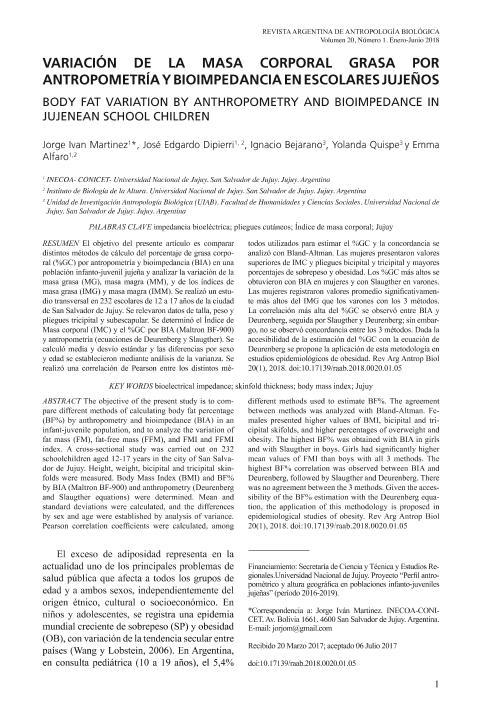Artículo
El objetivo del presente artículo es comparar distintos métodos de cálculo del porcentaje de grasa corporal (%GC) por antropometría y bioimpedancia (BIA) en una población infanto-juvenil jujeña y analizar la variación de la masa grasa (MG), masa magra (MM) y de los índices de masa grasa (IMG) y masa magra (IMM). Se realizó un estudio transversal en 232 escolares de 12 a 17 años de la ciudad de San Salvador de Jujuy. Se relevaron datos de talla, peso y pliegues tricipital y subescapular. Se determinó el Índice de Masa corporal (IMC) y el %GC por BIA (Maltron BF-900) y antropometría (ecuaciones de Deurenberg y Slaugther). Se calculó media y desvío estándar y las diferencias por sexo y edad se establecieron mediante análisis de la varianza. Se una correlación de Pearson entre los distintos métodos utilizados para estimar el %GC y la concordancia analizó con Bland-Altman. Las mujeres presentaron valores superiores de IMC y pliegues bicipital y tricipital y mayores porcentajes de sobrepeso y obesidad. Los %GC más altos se obtuvieron con BIA en mujeres y con Slaugther en varones. Las mujeres registraron valores promedio significativamente más altos del IMG que los varones con los 3 métodos. La correlación más alta del %GC se observó entre BIA y Deurenberg, seguida por Slaugther y Deurenberg, sin embargo no se observó concordancia entre los 3 métodos. Dada la accesibilidad de la estimación del %GC con la ecuación de Deurenberg se propone la aplicación de esta metodología en estudios epidemiológicos de obesidad. The objective of the present study is to compare different methods of calculating body fat percentage (BF%) by anthropometry and bioimpedance (BIA) in an infant-juvenile population, and to analyze the variation of fat mass (FM), fat-free mass (FFM), and FMI and FFMI index. A cross-sectional study was carried out on 232 schoolchildren aged 12-17 years in the city of San Salvador de Jujuy. Height, weight, bicipital and tricipital skinfolds were measured. Body Mass Index (BMI) and BF% by BIA (Maltron BF-900) and anthropometry (Deurenberg and Slaugther equations) were determined. Mean and standard deviations were calculated, and the differences by sex and age were established by analysis of variance. Pearson correlation coefficients were calculated, among different methods used to estimate BF%. The agreement between methods was analyzed with Bland-Altman. Females presented higher values of BMI, bicipital and tricipital skifolds, and higher percentages of overweight and obesity. The highest BF% was obtained with BIA in girls and with Slaugther in boys. Girls had significantly higher mean values of FMI than boys with all 3 methods. The highest BF% correlation was observed between BIA and Deurenberg, followed by Slaugther and Deurenberg. There was no agreement between the 3 methods. Given the accessibility of the BF% estimation with the Deurenberg equation, the application of this methodology is proposed in epidemiological studies of obesity.
Variación de la masa corporal grasa por antropometría y bioimpedancia en escolares jujeños
Título:
Body fat variation by anthropometry and bioimpedance in jujenean school children
Martinez, Jorge Ivan ; Dipierri, Jose Edgardo; Bejarano, Ignacio Felipe; Quispe, Yolanda; Alfaro Gómez, Emma Laura
; Dipierri, Jose Edgardo; Bejarano, Ignacio Felipe; Quispe, Yolanda; Alfaro Gómez, Emma Laura
 ; Dipierri, Jose Edgardo; Bejarano, Ignacio Felipe; Quispe, Yolanda; Alfaro Gómez, Emma Laura
; Dipierri, Jose Edgardo; Bejarano, Ignacio Felipe; Quispe, Yolanda; Alfaro Gómez, Emma Laura
Fecha de publicación:
01/2018
Editorial:
Universidad Nacional de La Plata
Revista:
Revista Argentina de Antropología Biológica
ISSN:
1514-7991
e-ISSN:
1853-6387
Idioma:
Español
Tipo de recurso:
Artículo publicado
Clasificación temática:
Resumen
Palabras clave:
IMPEDANCIA BIOELÉCTRICA
,
PLIEGUES CUTÁNEOS
,
ÍNDICE DE MASA CORPORAL
,
JUJUY
Archivos asociados
Licencia
Identificadores
Colecciones
Articulos(INECOA)
Articulos de INSTITUTO DE ECORREGIONES ANDINAS
Articulos de INSTITUTO DE ECORREGIONES ANDINAS
Citación
Martinez, Jorge Ivan; Dipierri, Jose Edgardo; Bejarano, Ignacio Felipe; Quispe, Yolanda; Alfaro Gómez, Emma Laura; Variación de la masa corporal grasa por antropometría y bioimpedancia en escolares jujeños; Universidad Nacional de La Plata; Revista Argentina de Antropología Biológica; 20; 1; 1-2018; 1-8
Compartir
Altmétricas



